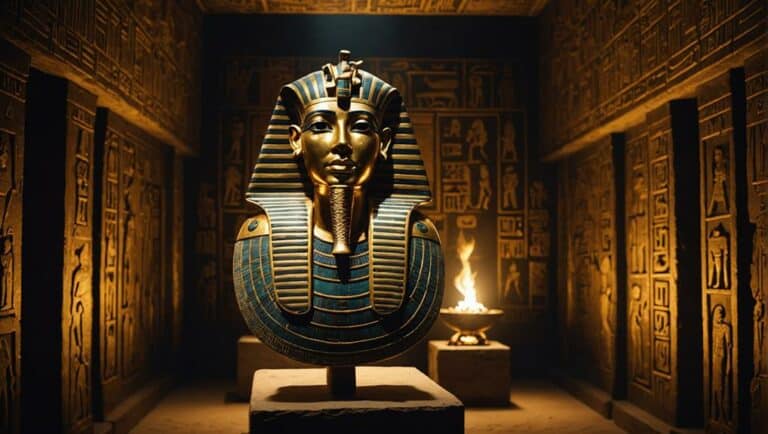King Tutankhamun's true cause of death remains a captivating enigma, with modern forensic techniques unveiling clues like a pre-mortem thigh fracture and genetic conditions.
Could malaria and a deadly infection from his injuries have sealed the fate of this young pharaoh?
Historic Discovery of King Tut
How did the discovery of King Tut's tomb by Howard Carter in 1922 revolutionize our understanding of ancient Egyptian burial practices?
When Carter discovered King Tut's tomb in the Valley of the Kings, it was a groundbreaking moment for archaeology. The tomb, remarkably intact, provided an unprecedented glimpse into the funerary customs of ancient Egypt's royalty.
Inside King Tut's tomb, you'd find a wealth of artifacts, from golden chariots to ornate jewelry, each item meticulously placed to accompany the young pharaoh in the afterlife. These treasures not only highlighted the wealth and artistry of ancient Egyptian civilization but also offered insight into the religious and cultural beliefs surrounding death and the afterlife.
The discovery of Tut's mummified body in a gold coffin was particularly revealing. The intricate embalming techniques, the use of amulets, and the placement of the body all provided valuable information about the mummification process and the significance of preserving the body for the afterlife.
In essence, Howard Carter's discovery of King Tut's tomb offered a detailed and tangible understanding of ancient Egyptian burial practices, enriching our knowledge of a civilization that continues to fascinate and intrigue scholars and enthusiasts alike.
Theories on Tut's Death
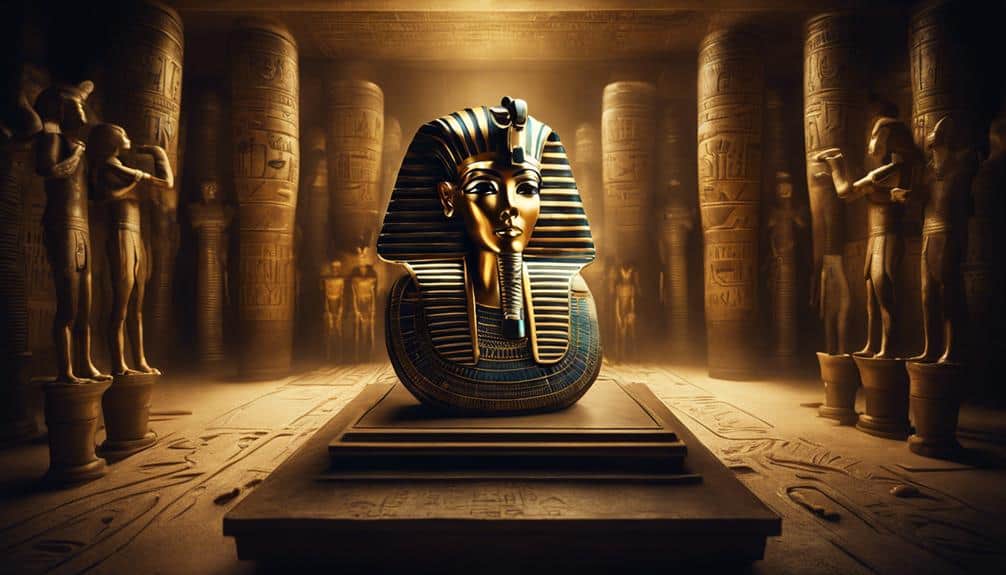
While the discovery of King Tut's tomb shed light on ancient Egyptian burial practices, it also sparked numerous theories regarding the young pharaoh's untimely death. Scholars have debated various causes of death, ranging from a potential chariot crash to infections and blood poisoning. Each theory offers a unique perspective on the circumstances surrounding King Tut's demise.
Some researchers suggest that a chariot accident could explain the fractures found on Tut's body. The high speed and impact of a chariot crash might've caused severe physical trauma, contributing to his death.
Another prevailing theory posits that infections, possibly resulting from these injuries, led to complications like sepsis or blood poisoning. Modern forensic techniques have provided additional insights into the cause of death.
DNA tests revealed that Tut suffered from malaria, which could have weakened his immune system and exacerbated other health issues. Additionally, genetic conditions evident in his DNA might've played a role in his vulnerability to various ailments.
Despite his brief reign and being erased from historical records, King Tut's death remains a subject of intense scholarly debate. Theories on Tut's death continue to evolve as new evidence emerges, shedding light on this ancient mystery.
Examination of the Mummy
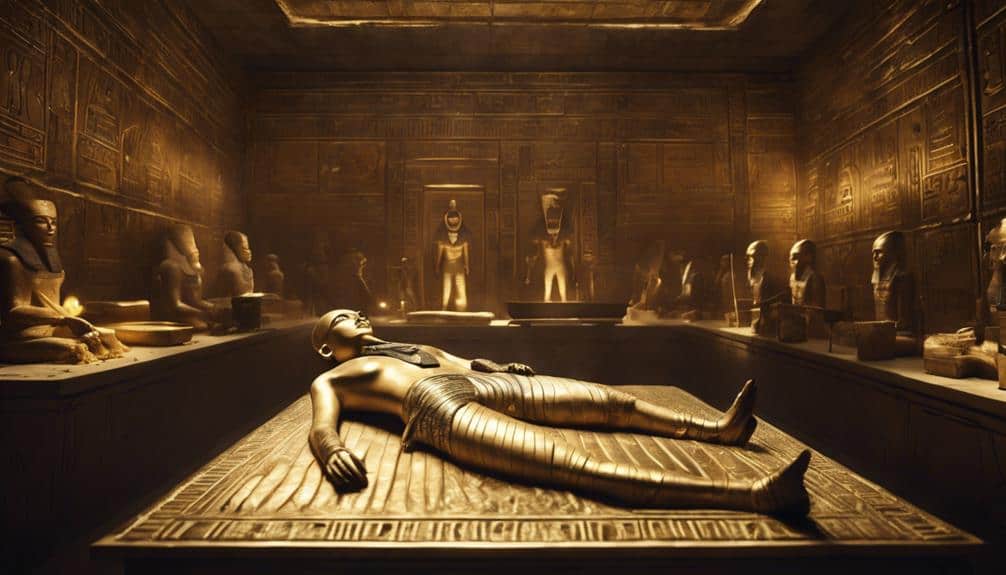
Examining Tutankhamun's mummy with modern forensic technologies has revealed significant details about his health and the circumstances surrounding his death. CT scans and DNA tests have provided a clearer picture of Tut's mummy, allowing researchers to explore further into the mummification process and the condition of his remains.
When you look at the findings, several important aspects stand out:
- CT scan: Detailed imaging revealed a fracture in Tut's thigh bone, which had traces of embalming resin, indicating the injury occurred before his death.
- DNA tests: These tests have helped identify genetic disorders and potential health issues that could have contributed to his untimely demise.
- Embalming resin: The presence of resin in the fracture highlights the meticulous mummification process carried out by ancient embalmers.
- Tut's health: The forensic technologies have uncovered evidence of malaria and bone abnormalities, suggesting he may have been frail.
- Forensic technologies: Advanced tools and techniques have allowed for a non-invasive examination, preserving the integrity of Tut's mummy.
Through these investigations, you gain a deeper understanding of the challenges King Tut faced during his life, laying the groundwork for ongoing research to unravel the mystery of his death.
Modern Forensic Discoveries
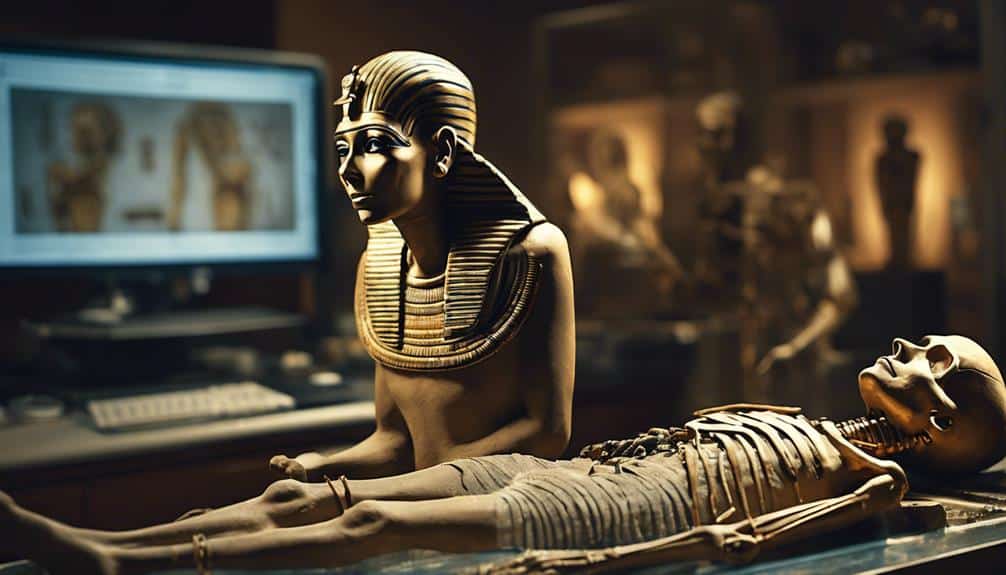
You're about to explore how modern forensic techniques have transformed our understanding of King Tut's death. These methods include advanced imaging and genetic analysis. They have uncovered critical information about his injuries and health, ruling out previously suspected conditions like Marfan's syndrome.
Advanced Imaging Techniques
Advanced imaging techniques, such as CT scans and DNA tests, have revolutionized our understanding of King Tut's health and the circumstances surrounding his death. These forensic technologies have revealed critical insights and solved longstanding mysteries about the young pharaoh.
CT scans conducted in 2006 exposed a significant fracture in King Tut's thigh bone, with traces of embalming resin indicating that the injury occurred before his death. This discovery has led researchers to explore several possible causes of death, including complications from the fracture.
Modern forensic discoveries have also ruled out Marfan's syndrome as a potential cause. Ongoing advancements in forensic technologies continue to offer hope for unraveling more details about his untimely demise.
Here are some key findings from using advanced imaging techniques:
- CT scans exposed a pre-mortem fracture in the thigh bone.
- DNA tests have ruled out genetic disorders like Marfan's syndrome.
- Forensic technologies have provided a clearer picture of Tut's overall health.
- Embossing resin traces suggest the fracture was treated during his lifetime.
- Ongoing research aims to uncover more clues about King Tut's death.
These advancements demonstrate the power of modern forensic tools in shedding light on historical enigmas, enhancing our understanding of King Tut's life and death.
Genetic Analysis Results
Building on the revelations from advanced imaging techniques, modern genetic analysis has uncovered that King Tutankhamun suffered from several genetic and medical conditions, including a club foot, a cleft palate, and possibly Kohler disease. These findings highlight the extent of his physical ailments, which were likely worsened by genetic disorders resulting from his parents being siblings.
Further genetic analysis pointed to familial temporal lobe epilepsy, suggesting that King Tut may have experienced seizures. This condition, combined with his other medical issues, could have greatly impacted his overall health. Additionally, the presence of the malaria parasite, Plasmodium falciparum, was detected in his DNA. This discovery is particularly important, as it revealed that Tutankhamun had multiple strains of malaria, which indicates a recurring and debilitating infection.
These genetic insights not only shed light on Tutankhamun's health but also provide a clearer picture of the challenges he faced during his short life.
The combination of genetic disorders and medical conditions, such as malaria and epilepsy, likely contributed to his untimely death. This in-depth genetic analysis therefore offers a more detailed understanding of the young pharaoh's demise.
Injury and Health Findings
Uncovering the details of King Tutankhamun's injuries, modern forensic discoveries have revealed a significant fracture in his thigh bone. This finding is pivotal for understanding his death and health. The fracture, which likely occurred before his death, contained traces of embalming resin, suggesting the injury was substantial and recognized during the embalming process.
CT scans have provided invaluable insights:
- Fracture Location: A clear fracture in the left femur.
- Embalming Resin: Presence in the fracture indicates pre-mortem injury.
- Health Indicators: Evidence of multiple health issues, including potential infections.
- Infection Risks: The fracture likely led to an infection, contributing to his death.
- Disease Ruling: CT scans have ruled out several diseases previously suspected.
These forensic findings highlight the limitations of ancient medical knowledge. The substantial injury to his thigh, combined with the lack of effective medical treatment, likely led to a fatal infection. This aligns with the hypothesis that King Tut's death wasn't due to immediate trauma but rather complications arising from his injury and subsequent health decline.
Ongoing research continues to employ advanced forensic technologies to further elucidate the circumstances surrounding his untimely death.
Impact of Tut's Death
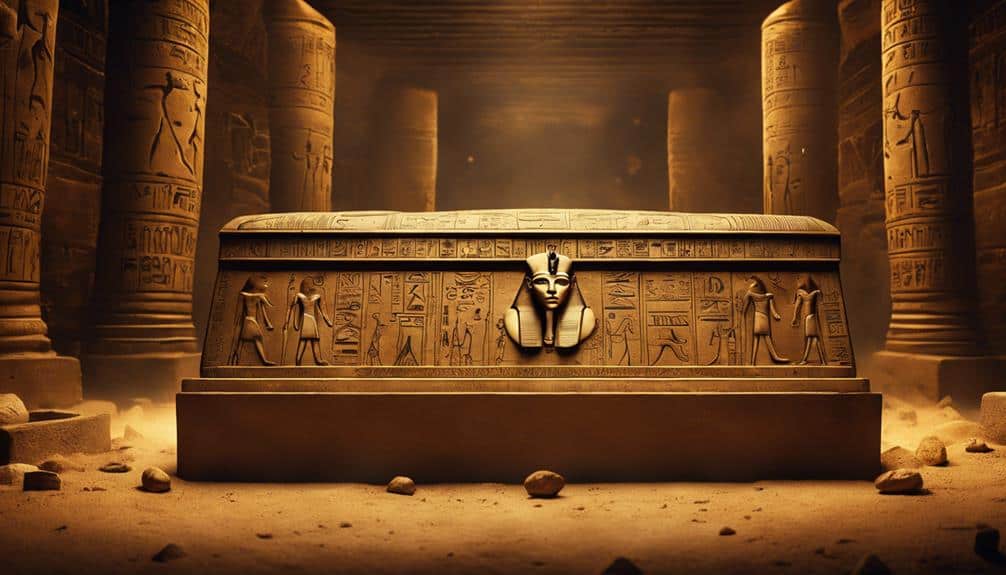
King Tut's untimely demise greatly influenced his legacy, capturing the fascination of historians and the public alike.
The discovery of his tomb in 1922 provided invaluable insights into ancient Egyptian culture and burial practices.
As you explore the archaeological findings, you'll see how they revealed the profound historical importance of the young pharaoh's reign.
Legacy of Young Pharaoh
The untimely death of Tutankhamun at such a young age profoundly impacted ancient Egypt, leaving a heritage that continues to captivate historians and archaeologists alike. At just 18-19 years old, Tut died, plunging the kingdom into uncertainty and highlighting the fragility of young leadership. The cause of death remains a subject of intense speculation, sparking countless theories over the years.
Tut's death underscored several critical aspects of that era:
- Political Instability: His passing led to shifts in power dynamics and political alliances within ancient Egypt.
- Medical Limitations: The fracture in his thigh bone revealed the inadequacies of ancient medical practices.
- Cultural Insights: The contents of his tomb provided a wealth of information about the period's art, religion, and daily life.
- Modern Forensics: Advances in forensic technology have allowed for a deeper investigation into his cause of death.
- Global Fascination: The discovery of Tut's tomb in 1922 reignited global interest in ancient Egyptian history.
Tutankhamun's legacy is a confirmation to the enduring intrigue surrounding ancient Egypt and the mysteries that still linger about his brief reign and untimely demise. His life and death offer invaluable insights into the complexities of ancient civilizations.
Archaeological Significance Unveiled
Drawing from the profound mystery of Tutankhamun's death, the discovery of his tomb in 1922 greatly advanced our understanding of ancient Egyptian archaeology and burial customs. The condition of Tutankhamun's remains and the treasures within his tomb provided unparalleled insights into the practices and beliefs of ancient Egypt.
X-rays taken of Tutankhamun's body revealed a fracture in his thigh bone, suggesting that a chariot crash might've contributed to his untimely death. This finding not only pointed to the possible circumstances under which he might've been killed but also highlighted the limitations of ancient medical knowledge and treatment. The infection likely resulting from the injury underscored the harsh realities of medical conditions in that era.
The magnificent death mask of Tutankhamun and the wealth of artifacts found within his tomb emphasized the archaeological significance of his burial. These discoveries offered a rare glimpse into the opulence and complexity of royal burials in ancient Egypt.
The ongoing fascination with Tutankhamun's death has fueled continued interest in archaeology and historical research, deepening our collective understanding of this enigmatic civilization. Through these findings, we gain a richer appreciation of ancient Egyptian life and death.
Ongoing Research and Future Insights
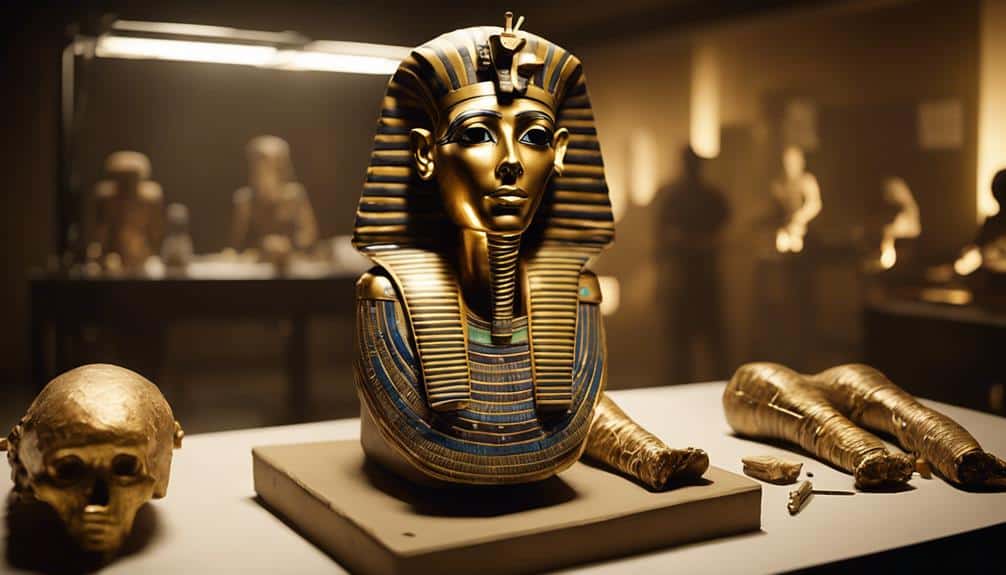
Modern forensic technologies, including DNA tests and CT scans, promise to shed new light on the perplexing circumstances of King Tut's death. These advanced methods provide unprecedented insights into Tut's health and potential causes of death, fueling ongoing efforts to unravel the mystery surrounding his untimely demise.
DNA tests have already provided clues about genetic disorders and infections that may have plagued the young pharaoh. For instance, they suggest that a pre-death thigh bone fracture could have led to a fatal infection or disease. CT scans, on the other hand, offer detailed images of Tut's skeletal structure, revealing injuries and abnormalities that traditional examinations couldn't detect.
Here are some critical areas where modern forensic technologies are making a difference:
- DNA tests: Identifying genetic markers for diseases and infections.
- CT scans: Offering detailed imagery to detect injuries and bone conditions.
- Tut's health: Gaining a thorough understanding of his physical state.
- Potential causes of death: Narrowing down the possibilities through scientific evidence.
- Ongoing efforts: Continuously employing new methods to solve the ancient mystery.
These technologies, while not providing all the answers yet, certainly bring us closer to understanding the true cause of King Tut's death.


